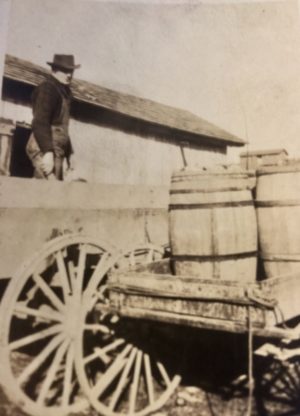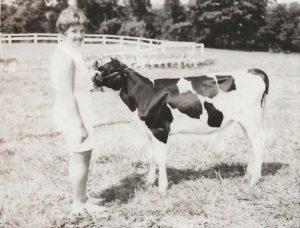The connection of farm to plate is not a new concept to me – actually it’s part of my DNA. So as the new-found love for “everything local” and the renewed interest for understanding the farm-to-plate connection has developed over the years, I have to sit back and ponder, “When did we lose the farm to food connection?”

My grandfather working on the family farm
For those of us who have grown up on farms and around agriculture, there was initially a perception that a “common” understanding and trust for farmers and agriculture was inherent and everyone “just understood”! But we know that’s not the case and perhaps a reflection on why we lost the connection is best viewed through my own family generations. To set the stage, let’s roll back the clock and reflect on what farming looked like in four successive generations: my grandparents, my parents, my brother and I, and now my nephew.
Early Agricultural Prosperity
My grandparents were born in 1900. My grandfather Smith was born and raised (and lived) on a farm that had already provided a living for three previous generations since migrating from Virginia to Kentucky. In the 1900s, there was agricultural prosperity with the western plains still being settled. The U.S. population was almost 76 million with approximately 38 percent of the population working on farms. There were more than 5.7 million farms with an average size of 147 acres.

My father, post WWII, on the original Smith farm
By the mid-1920s when my parents were born, the country’s population had grown to over 100 million with 27 percent of the population living on farms. While farms had grown to number 6.5 million, the size of the average farm remained under 150 acres. Agricultural exports were already big business making up 42 percent of total U.S. exports.
Despite the Great Depression of the 1930s, farm production gradually grew due to expanded use of mechanized power. My family members were able to keep their farms due to the longevity of ownership. Also, during this time, 31,000 students were enrolled in agricultural courses at land grant colleges, which had been established in the late 1880s. And research being done at these colleges between 1925 and 1945 built the foundation for the second agricultural revolution.
Leaving the Farm

My brother on the family dairy farm
By the time my brother arrived in the late 1940s, post-World War II, the total U.S. population was over 130 million, but the farm population was starting to fall slightly. Farmers now made up only 18 percent of the labor force, down nine percent from the time my parents were born. Southern tenant farmers were leaving farms for city war-funded jobs. Farm ownership decreased by 400,000 though the average size of a farm increased to 175 acres.
A farmer in the 1940s could supply food for approximately 11 people. From the time of my parents’ childhood to my brothers,’ horses stepped aside for tractors and the availability of technology launched the second American agricultural revolution. Productivity per acre began to rise. Agricultural exports increased in dollar value but were only 22 percent of U.S. trade. Also during the 1940s, frozen food was popularized, the United Nation’s Food & Agriculture Organization as well as other international food programs were established, and more pesticides and herbicides were used in farming as crop size increased.
Production & Distribution Revolution
When the 1950s rolled around, so did I and our society continued to change. Our population was now over 150 million but farm population had decreased and farmers were only 12 percent of the labor force – more than a 50 percent decrease from when my parents were young. The number of farms stood at 5.4 million — a decrease of 700,000 in 10 years — but the average farm was now over 216 acres with more irrigated acres in production. One farmer could supply food for 15.5 persons.

Showing calves in a 4-H Dairy show
as a young girl
During the 1950s, interstate highways were being built and in 1954, the number of tractors on farms exceeded the number of horses and mules for the first time! Mechanization and transportation allowed farmers to grow more and the distribution of food was forever changed. With the improvement of transportation and the availability of cars, family members were leaving the farm for city jobs but the connection to the farm remained strong.
By the time my nephew, the seventh generation of our family, was born in the early 1980s, the U.S. population had grown by 77 million but the farm population had diminished to 6 million – approximately one fourth of the farm population 30 years earlier. Farmers now represented just 3.4 percent of the labor force – approximately a 75 percent reduction from 30 years prior. The number of farms had decreased almost by half to 2.4 million but the average size had doubled to 426 acres. One farmer could supply food for 76 people – five times more than when I was a kid.
But in this era economics played a big role and proved once again that farming is not for the “faint of heart.” Droughts, devaluation of farm land, increased foreign purchase of U.S. farms, and increased global competition were a “mixed bag” for farmers. Conservation measures like no-till planting and the introduction of biotechnology led to improvements in farming efficiency and sustainability. But benefits never exist without risks and USDA scientists began to recognize potential environmental side effects of efficiency farming.
A Return to the Land
In the 1990s, farm production grew along with the population. Rural population numbers grew as individuals traded crowded cities for the tranquility of “country living.” But without an understanding of agriculture, tensions often occurred when the sounds and smells of true rural life breezed through the windows of the new country dwellers! Farmland was becoming subdivisions as the country’s population continued to rise. With the majority’s loss of farming knowledge, came a rising disconnect with how food was grown. Opposition to practices such as increased use of biotechnology and concerns about the environmental impact of livestock also grew — a fact that was not lost on the agricultural community but was met with questions of curiosity and astonishment. The business of growing food is complex but simplicity was being desired. Farmers’ markets grew and organic agriculture production legislation was passed as the “locavore” revival began.
Today, as the eighth generation of Smiths are growing up, we are a society of 324 million with only two percent of the population engaged in farming. But 100 percent of us want to understand how our food is grown. Farmers produce 262 percent more food with two percent fewer inputs (labor, seeds, feed, fertilizer, etc.) than in 1950. The number of farms has continued to shrink to around two million with more diversity of farm size. Today, farm sizes range from urban farming structures to one acre specialty farms, to standard acreage of 231 acres for small farms, to 1,421 and 2,086 acres for large and very large farms, respectively. However, the vast majority, 88 percent, of today’s farms are small, self-managed operations. And 98 percent of farms remain family owned.
Where Do We Go from Here?
We have come a long way since my ancestors began farming in Kentucky over 150 years ago. Some may view it as progress and others may say “we’ve lost our way.” Regardless of the perspective, farming, in general, has remained economically and sustainably viable due to improvements in soil health, water management and improved crop production. But is it sustainable for the future? Will the crops we raise today actually sustain the health and well-being of our nation and the world? Are we raising food for nutrient benefits or economic gain? Is having an affordable and safe food supply enough? These are all complex questions without simple answers! Resolution comes with understanding our food systems and consumer concerns. It will do us well to reconnect ourselves and “meet at the table” with our neighbors and communities.
Data Source: https://www.agclassroom.org/gan/timeline
